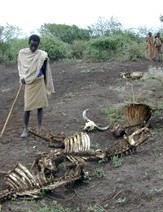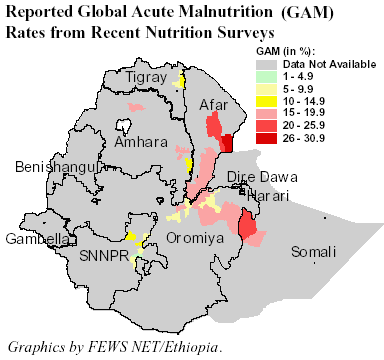|
afrol News, 9 January - "Compelling evidence" indicates that people are facing pre-famine conditions that are graver than in 1984, when 1 million people died of hunger in Ethiopia. Widespread livestock deaths have been accompanied by distress sales of weakened, lower-value animals. Grain prices have increased abruptly over the past 5-6 month as food is getting short in supply. According to a food security emergency report published today by the US agency Famine Early Warning Systems Network (FEWS), all signs point towards famine in Ethiopia if the international community and the government do not take necessary action. People were facing pre-famine conditions in the provinces of Afar, Tigray, Amhara, Oromiya and Somali, as well as locations in the south, FEWS reports. - Households whose livelihoods largely depend on crop and livestock production will suffer substantially reduced crop yields or near-complete crop failure due to low and erratic rainfall during the two consecutive rainy seasons (belg and meher), the agency reports from Ethiopia. This was "an unusual occurrence within the same year." Further, widespread livestock deaths in Afar and Somali Regions that peaked between June and August had been accompanied by distress sales of weakened animals and sharply worsening terms of trade (the volume of cereals that can be obtained in exchange for one animal) for pastoralists and agro-pastoralists. Livestock prices are declining in many areas. At urban markets, grain prices have soared over the past 5-6 months. "Unseasonably early increases in grain prices in some rural markets have already put food staples out of reach of poor households," FEWS observes. Given overall decline in the production of cereals in the country, prices could be "expected to further increase before the next minor season harvest in June."
In cash crop producing areas in western, southwestern and eastern parts of the country, the coffee harvest is estimated to have declined by 20 to 30 percent this year due to the drought, adversely affecting the incomes of up to 15 million Ethiopians. FEWS reports that, "as traditional livelihood strategies continue to weaken, there is widespread evidence of increased sales of both non-productive and productive household assets (such as jewelry and plow oxen, respectively) and consumption of wild 'famine foods', some of which are toxic unless prepared properly." The current food crisis was "particularly dangerous," FEWS notes, "because Ethiopia is susceptible to an accelerated deterioration of food security and the rapid onset of famine conditions in the next 2-3 months." If external aid does not arrive, the famine could become graver that the infamous 1984/85 famine. - In contrast to conditions at the time of the 1984/85 famine that resulted in one million deaths, there are considerably more people in need of food aid (11.3 million in 2003 versus 8 million in 1984/85), FEWS warns. "Declining per capita income (US$ 108 in 2001 vs US$ 190 in 1981) severely limits purchasing power in the face of rising prices. Moreover, a rapid annual population growth rate of 2.9 percent also means that Ethiopia produces less cereals and pulses per capita." According to a December appeal by the Ethiopian government, 11.3 million Ethiopians will require over 1.44 million metric tons of emergency food assistance during 2003, with monthly needs peaking during the March-June period. An additional 3 million highly vulnerable people would require close monitoring. The government has also asked for US$ 75 million in additional non-food donor assistance. While some food donations have been made and the debt-burdened Ethiopian government is purchasing food on the international market, FEWS reports that supply is short. Current aid was only sufficient to cover 52 percent of first quarter needs. "Unless additional food assistance is urgently pledged and delivered, this could lead to a disruption in food aid distribution and widespread starvation and mortality in Ethiopia," the agency warns. Sources: Based on FEWS and
afrol archives
|
front page
| news
| countries
| archive
| currencies
| news alerts login
| about afrol News
| contact
| advertise
| español
©
afrol News.
Reproducing or buying afrol News' articles.
You can contact us at mail@afrol.com


